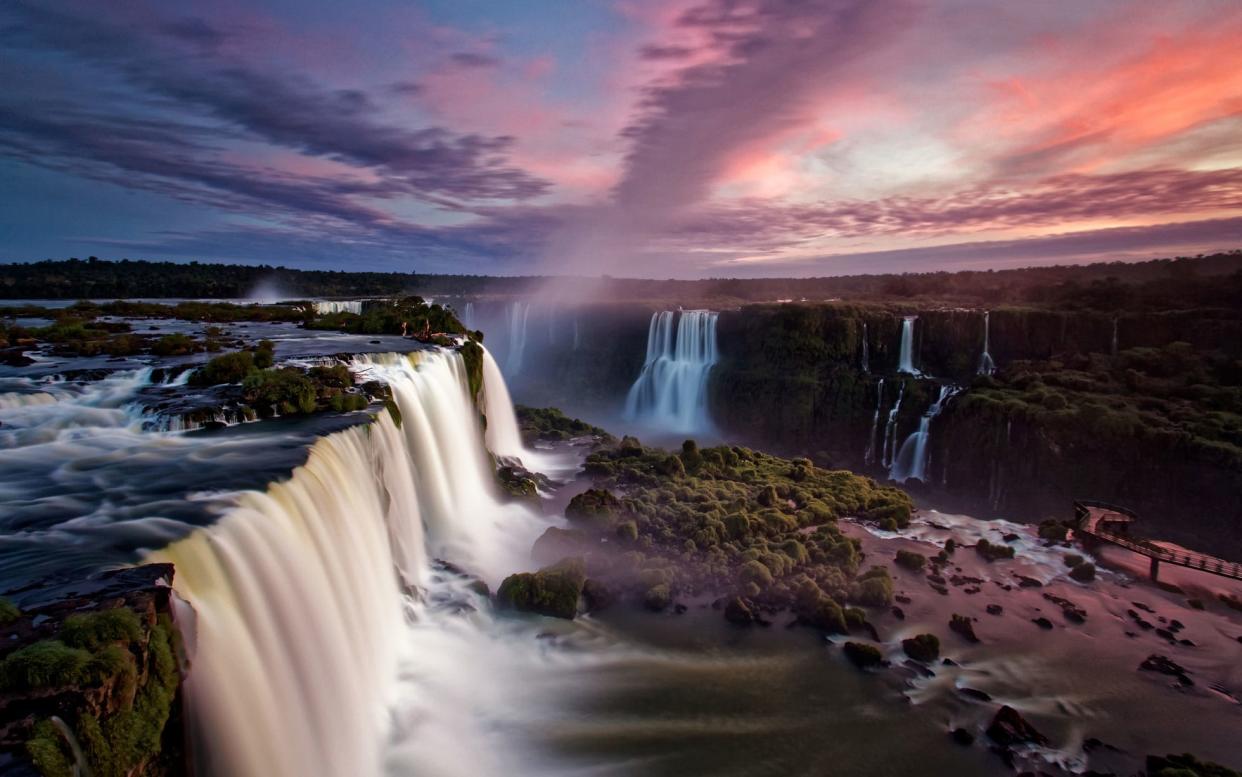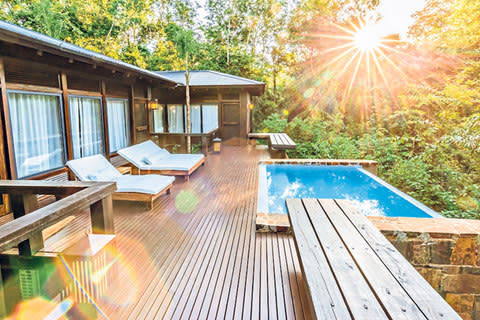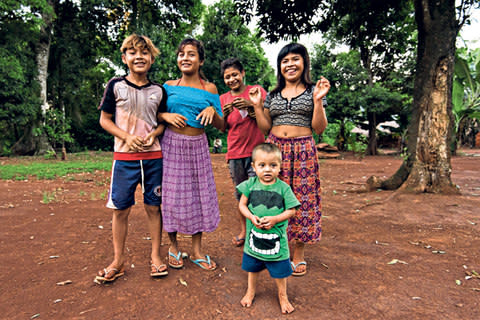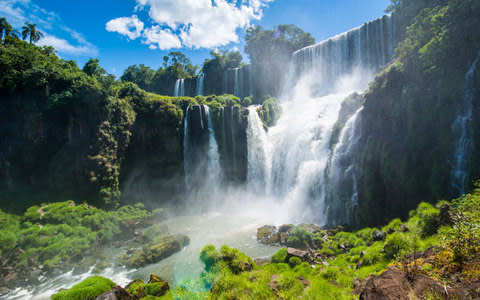A luxury lodge offers a new way to explore one of South America's greatest natural wonders

Louder than a thousand hooves thundering into battle, a cavalry of watery white horses gallops into the mouth of the canyon, leaving plumes of drenching spray in its wake.
In the late afternoon sun, a rainbow of colours is refracted through the mist, forming Technicolor hoops for acrobatic dusty swifts and yellow butterflies carried on the crest of a heaving groan so powerful that it could echo for an eternity.

Indigenous Guarani people appropriately named this insatiable cataract the Devil’s Throat, fearing it capable of swallowing everything in its path. Even today, they refuse to venture this close and believe only those obeying divine will should feel the need to make a one-way journey.
There’s something very compelling about Iguazu Falls, a curtain of thrashing water nearly two miles long, which is claimed to be the largest waterfall system in the world. So much so, up to 28,000 people a day visit during peak season, an unsustainable pressure that the authorities are now forced to address.
Voted by the public as one of the New Seven Wonders of Nature, Iguazu Falls spills over the Paraná Plateau, straddling southern Brazil and north-east Argentina, and is divided between two national parks. At the tip of a finger-tickling Paraguay, it’s an area defined by water. I explored the Brazilian side several years ago, but – like most – only stayed a couple of nights and didn’t venture much further than the park gate. Up until now, I’d been in no hurry to return.
That changed at the beginning of this year when a new high-end eco lodge, Awasi Iguazu, opened in the wilder, more rugged Argentinian sector, inviting guests to see the falls differently and within the broader cultural and geographical context of Misiones Province – which nobody has successfully pulled off before.
In 2007, the Argentinian government created a 1,500-acre buffer zone between the national park and Iguazu city, dividing the land between hotels and Guarani communities. Chilean-based company Awasi – which has adventure lodges in Patagonia and San Pedro de Atacama – secured one of those jungle plots, and its elegant 14-villa property has been a decade in the making.

A 20-minute drive from the park entrance, it shares the same Atlantic Forest ecosystem, with dense vegetation embracing each private plunge pool. Use of sustainable native hardwoods and pine make it look and smell like a very comfortable extension of the outdoors, while botanical drawings hanging on walls clearly illustrate the direction Awasi is keen to take.
Unique in South America, the company operates a private guide system – with one adventure expert and vehicle allocated to each guest – tailoring a choice of activities in the area to an individual itinerary. Everyone, though, visits the falls.
The first white man to discover Iguazu (meaning “big water” in Guarani) was the Spanish explorer Alvar Núñez Cabeza de Vaca in 1541. Given to the Ayarragaray family by the Spanish crown, the land remained in private hands until the early 20th century and was finally declared a national park in 1934 – the second in Argentina – partially on the basis of recommendations by the Italian botanist Carlos Bosetti and landscape architect Charles Thays.
By then, human activity had already taken its toll and an emergence canopy of rosewood trees is still noticeably absent from the riverbanks. Development in the park was slow, although improved infrastructure in 2000 increased visitor numbers fivefold.
The world's 10 most beautiful waterfalls (and how to see them)
“Here, you don’t just see the falls – you feel them,” explains my jovial Awasi guide, Maria Leal Prono, as we walk along the lower circuit, catching tantalising glimpses of a gleaming white horseshoe gushing with more than 250 individual waterfalls – a number that changes depending on the rains. Along with the upper circuit, Devil’s Throat and Macuco Trail, there are five miles (eight kilometres) of public paths in the park compared with less than a mile on the Brazilian side – an area that is ironically three times as big.
Blush-crested jays swoop between treetops and black vultures soar on thermals, two of the 500 bird species sought for on Awasi’s new early morning birdwatching walks. Granting the only out-of-hours access to the park, it’s a genuine privilege for guests. By 10am, the day has already heated up – and so too have the crowds, creating a furious symphony of selfie snapping.
Seeking silence, we drive for two hours along National Road 101 and a rust-red dirt track to reach the Yacui Reserve, a swathe of forest flourishing with native rosewood and palm heart trees and partially managed by Awasi. We are greeted by a Mr Kelm, a blond, wiry gentleman who takes care of several kayaks, which we use to paddle along a calm, quiet tributary of the Iguazu river, where dragonflies and driftwood are the only passing traffic.
Afterwards we hike a trail so thick with ferns and root buttresses, even shards of light struggle to penetrate; entering a cathedral of trees, we bow beneath gossamer arches spun by golden orb spiders and butterfly wings fluttering like petals of confetti. Further south, jaguars and tapirs have been sighted, but here the focus is on small things and there’s even talk of using microphones to amplify the sound of ants at work.

Although the oldest inhabitants of this land, only 6,000 Guarani people still live in Misiones, including the small community of Jasy Bora (Pretty Moon) neighbouring Awasi. “They call us the man who speaks a lot but says very little,” explains Maria, as we enter the jungle settlement, where bashful women sell jewellery made from painted seeds at the roadside, and squealing children chase each other barefoot through the dirt.
Our private appointment is with 21-year-old Sergio, nominated by chiefs as a guide. Surprisingly, he is early. With no watches or calendars to govern their days, the Guarani have little sense – or concern – for passing time. “Only when the lapacho tree blossoms in September do we know that winter has come to an end,” softly spoken Sergio tells me.
Although they adopted Western dress a long time ago, the community still clings tightly to its culture. Bouquets of dried yerba mate leaves and bamboo music sticks have been laid out for a private ceremony that evening.
“In this land, no one is the owner,” explains Sergio, who – like most of his friends and family – has never visited the falls. “Only money puts a price on land.” Divided by political borders, the community is now dispersed across different countries, but their cultural identity remains the same. So what frightens this father of two most?
The best hotels in South America
Although he struggles to find words, I suspect language is not the barrier; living in the present, the concept of a future simply doesn’t exist. But looking around me at a shrinking forest, where roads now reach their doorways, I have a good idea.
The Guarani’s survival thus far is partly due to the remarkably peaceful relationship they shared with Jesuit orders sent by the Spanish crown in the 17th century to evangelise the
New World’s indigenous population. Although coerced into adopting Christianity, the Guarani were allowed to maintain their language (it was even transcribed for the first time) and continue drinking yerba mate. In return, they welcomed European protection from rival tribes.
Driving 160 miles (260km) south along the Paraná – one of the longest rivers in the world – we reach San Ignacio Miní, the largest and best preserved of the Argentine missions. In these complexes, these synchronised cultures coexisted until the Jesuits were expelled in 1767.
Vines creep around baroque ruins, attempting to reclaim their space. Now, only stories and imagination fill gaps between the stone columns and the sky.

In total, 30 missions were constructed across Brazil, Paraguay and Argentina, countries divided by rivers and waterfalls. In the neighbouring province of Corrientes, 70 miles (113km) from San Ignacio Miní, I arrive at another of Argentina’s most important aquatic features. Floodplains, rainwater lakes, pastoral land and dense Paranaense jungle form the Ibera Wetlands, creating an ecosystem similar to Brazil’s Pantanal – ideal habitat for capybaras, caiman, armadillos and (if reintroduction efforts go to plan) jaguars.
Built as an estancia in 1868, Hotel Puerto Valle sits on the banks of the Paraná, gazing across to Paraguay. Swollen in size by the completion of the Itaipu Dam in the early Eighties, water nibbles at its shoreline, flooding forests and creating a maze of petrified trees ideal for a sunset kayak ride.
Like the Iguazu region, human interference has altered the landscape: as stark, cold and upright as the teeth on a wire brush, eucalyptus trees planted in regimented rows only serve to highlight the beauty of chaotic native forest trailing with vines and howler monkey hollers. But unlike at Iguazu, there’s nobody here. Ibera (meaning “bright water” in Guarani) is a secret still relatively well kept.
10 places in South America you never thought to visit
While a spotlight has been cast on the national park further south, where conservationist Doug Tompkins successfully regenerated land, this northern sector sits under the radar. Hotel Puerto Valle has private access to the wetlands, launching shallow tin boats along narrow channels funnelling into a 150-mile (250km)-wide basin. Gasping caimans drop their jaws like drawbridges in the suffocating heat and crafty jacana birds piggyback on stocky capybaras for elevation above an otherwise untroubled horizon.
Despite its size, this isolated body of rainwater runs nowhere, explains our boatman Nicholas. Ten thousand years ago, the Paraná river coursed through this very patch, shaping the landscape and creating connections for communities and wildlife where divisions and borders now exist.
But it’s reassuring to know that not far from here, waterways continue to carve corridors, forging links and finding new paths irrespective of the lines we draw on maps. Like runaway horses, these big, bright waters keep charging. They are unstoppable.

Essentials
Abercrombie & Kent (01242 386476; abercrombiekent.co.uk) offers 11 days in Argentina from £5,585 per person including international flights, internal flights and transfers. This price includes three nights at 1828 Smart Hotel in Buenos Aires on a B&B basis, three nights at Hotel Puerto Valle, and three nights at Awasi Iguazu on a fully inclusive basis with guiding.
For a full review of Awasi Iguazu, see telegraph.co.uk/tt-awasi

